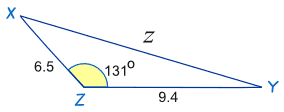The Sine Rule, also called the law of sines, is a rule of trigonometry that relates the sides of a triangle and its angle measurements. While most of trigonometry is based on the relationships of right triangles, the law of sines can apply to any triangle, whether or not it has a right angle.
Ang Sine Rule, na tinatawag ding batas ng sines, ay isang panuntunan ng trigonometry na nauugnay sa mga gilid ng isang tatsulok at mga pagsukat ng anggulo nito. Habang ang karamihan sa trigonometry ay batay sa mga ugnayan ng mga right triangle, ang batas ng mga sines ay maaaring mailapat sa anumang tatsulok, mayroon man itong right triangle o wala.
- The law of sines is stated as follows:

Kung saan ang A, B, at C ay sukat ng gilid ng isang tratsulok, samantalang ang
 ,
,  , at
, at  ay ang mga anggulo na katapat (opposite) ng gilid A, B, at C.
ay ang mga anggulo na katapat (opposite) ng gilid A, B, at C.
Tandaan na ang mga titik o simbolo sa mga gilid at anggulo ay maaaring anuman sa mga letra ng Abakada na Ingles o Griyego o kombinasyon nito. Ang mahalaga ay consistent tayo sa paggamit. Halimbawa, kung ang letra ng gilid ay A (o a), ang katapat na anggulo nito ay a (o A) at pabaliktad. Hindi rin mahalaga kung ang Angle ay nakasulat sa maliit na titik at ang titik ng gilid ay nakasulat sa malaking titik.
- The same rule can be rearranged to yield the following equivalent statements: (Ang Sine Rule ay maaari ring isulat tulad ng nasa ibaba:)

Kailan Maaaring Gamitin ang Sine Rule?
Ang batas ng sines ay pwedeng gamiting kung:
1. Alam mo ang sukat ng dalawang anggulo at isang sukat ng gilid (2 angles and 1 side), at isa sa anggulo at gilid ay magkapares. Ibig sabihin kung given ang Angle A, dapat ay given din ang side a; kung given ang side C, dapat given din ang Angle C.
2. Alam mo ang sukat ng dalawang gilid at isang sukat ng anggulo (2 sides and one angle), at at isa sa anggulo at gilid ay magkapares. Ibig sabihin kung given ang Side b, dapat ay given din ang Angle B; kung given ang side C, dapat given din ang Angle C.
Hindi maaaring gamitin ang Sine Rule sa mga sumusunod na sitwasyon:
a. Given Side a, Side b at Side c
Hindi ito maaari dahil kailangan natin ang isang anggulo.
b. Given Angle A, Angle B, at Angle C
Hindi magagamit dito ang Sine Rule dahil kailangan natin ang sukat ng isang gilid.
c. Given Side a, Side c, at Angle B
Hindi magagamit ang Sine Rule dito dahil kailangan ang magkapares na gilid at anggulo.
d. Given Angle B, Angle C, at Side a
Hindi maaaring magamit ang Law of Sines dito dahil walang magkapares na gilid at anggulo.
Sample Problems Using the Law of Sines
1. In a triangle ABC, if a = 2, b = 3 and sin A = 2/3, find Angle B
(If you cannot visualize the problem, it is recommended to draw the figure based on the given.)
Given: a = 2 ; b = 3; sin A = 2/3
Required: Angle B
Formula: a/sin A = b/sin B
Substitute the Given to the Formula:
2/ 2/3 = 3/sin b
2 x 3/2 = 3/sin B
6/2 = 3/ sin B
3 = 3/sin B
3 (1/3) = 1/3(3/sin B)
sin B = 1
B = sin^-1 (1) (arc-sin 1)
B = 90 degrees
2. Suppose you are given that side A is 12, angle  is 80 degrees, and angle
is 80 degrees, and angle  is 40 degrees. Find the length of side B.
is 40 degrees. Find the length of side B.
Given: side A = 12; angle  = 80 degrees; angle
= 80 degrees; angle  = 40 degrees.
= 40 degrees. Required: side B
Formula: A/sin  = B/sin
= B/sin 
Substitution: 12/sin 80 = B/sin 40
B = 12 sin 40 / sin 80
Find the value of sin 40 and sin 80 in the Trigonometric Table or in a Scientific Calculator.
sin 40 =0.6428 (rounded)
sine 80 = 0.9848 (rounded)
B = 12 (0.6428) / 0.9848
B = 7.7136/0.9848
B = 7.833 (rounded)
Solution :
∠A + ∠B + ∠C = 180˚
∠A + 45˚ + 105˚ = 180˚
∠A = 30˚
a/sin A = b/sin B = c/sin C
2/sin 30˚ = b/sin 45˚ = c/sin 105
2/(1/2) = b/(1/√2) = c/sin 105
4 = √2b
b = 4/√2 ==> 4√2/2 ==> 2√2
Hence the value of b is 2√2
References:


 ,
,









